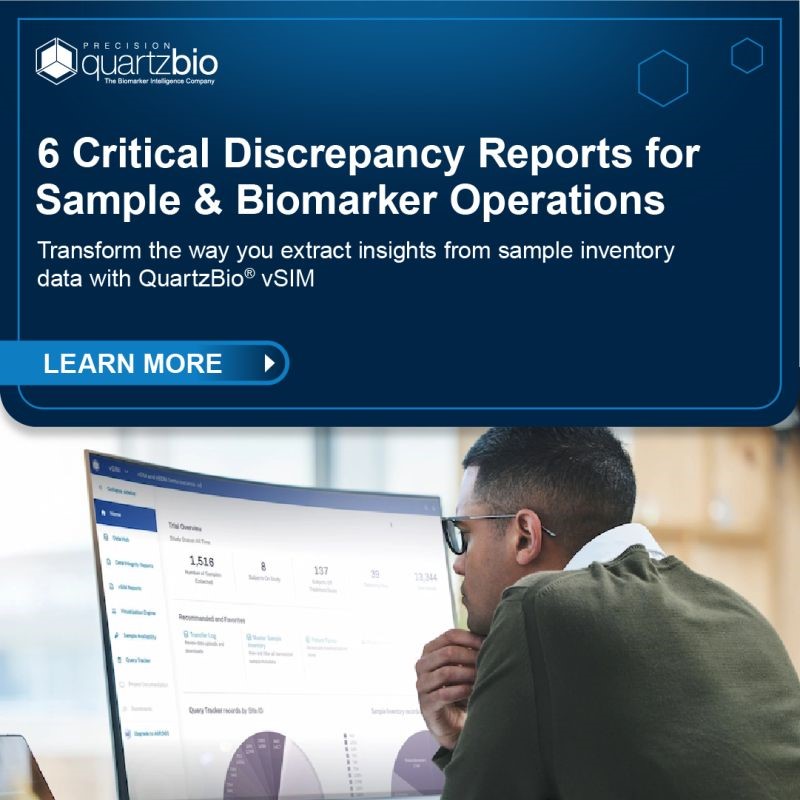
February 9, 2022 — Clinical operations leaders use the QuartzBio® virtual Sample Inventory Management (vSIM) solution to maintain robust visibility across sample collection and processing status, consent status, and sample and derivative quality information.
Traditionally, generating these reports is frustratingly time-consuming – often involving spreadsheets that attempt to manually link key information from the EDC, central labs, testing labs, and biorepositories to illuminate critical information like discrepancies or missed collections.
The QuartzBio team has identified six critical on-study reports that our clients prioritize as absolutely required for effective sample and biomarker operations.
Coupled with generating the reports continuously throughout the life of a study, our clients reiterate the need for teams to have collaborative visibility as new data are available.
In this quick guide, we highlight these six key reports – and introduce QuartzBio’s proprietary processing and harmonization pipelines that make them a reality (including for ongoing studies).
#1 Missing Samples
Clinical operations teams must extract information from multiple sources, including protocols, protocol revisions, and optional consent forms, to gain visibility into what samples and derivatives are expected to be collected.
Teams then compare these expectations to actual collection data. The resulting report can be tedious to generate.
With QuartzBio’s dynamic dashboards, the missing samples report is easy to access, filter, and share, saving clinical operations teams time and providing opportunities to intervene during the trial to minimize loss of critical specimens and data.

#2 Samples with Potential Consent Violations
When managing complex sample inventories across labs and repositories, clinical teams often spend time manually cross-referencing inventory data with informed consent forms and protocols.
QuartzBio accepts, reviews and houses the protocol under which each subject was enrolled, as well as consent forms. In addition to discrepancies in expected sample collection, QuartzBio can also detect and report instances where a sample was collected, but optional consent was not given.
In this example, the study has two optional consents, for genetic testing and biopsy sampling. In this report, three subjects did not consent to biopsy, but a biopsy was taken, violating consent.

#3 Subject IDs in Unrecognized Format
Pulling together sample inventories and metadata across sites, central, and testing labs is already a tedious task. Subject IDs that do not match the expected format prevent accurate reporting. Clinical teams frequently use the “Problematic Subject IDs” report in the QuartzBio® platform to quickly address these discrepancies.

#4 Missing EDC Collections or EDC Data Entry Errors
Samples without a recorded collection date in the EDC could either indicate a data entry error or, potentially, that a sample without a recorded collection in the EDC was received by the central or specialty lab. The latter could indicate a more serious issue at the site. With multiple labs and biorepositories, there are multiple points at which these errors can occur.
This QuartzBio® report lists samples whose collection date is more than 14 days prior to the last EDC export.

#5 Collection Dates Missing from Sample Inventory
Sometimes, the EDC is complete, but the inventory provided by a lab or repository is missing the corresponding collection data. This could occur where samples were either not accessioned properly, or where a given sample was never received. The ability to maintain continuous visibility enables teams to address discrepancies before more serious issues occur.

#6 Samples with Discrepant Sample Collection Entries (EDC vs. Inventory)
This report shows direct reconciliation issues between the EDC and inventories at central labs, specialty labs, and biorepositories. The vSIM solution is designed to streamline and automate the reconciliation, a time-consuming process that is typically manual and requires accessing multiple systems.

Summary
The six reports outlined in this quick guide represent the minimum requirements of most clinical operations teams as they monitor biospecimen operations in biomarker-informed trials generating complex data from multiple samples and derivatives. This foundation of visibility further enables clinical teams to project forward-looking sample collections and assay results data availability, confirm appropriate sample status prior to data generation, and monitor sample or consent expiry.
Continuously updated data and collaborative platform enable teams to work from a unified data set
Clinical teams frequently ask, “Is everyone working off the same data?”
With the QuartzBio® Data Platform, teams can rest assured that all team members across the organization, across functions, are accessing a centralized reliable source of sample information. QuartzBio’s data ingestion and harmonization pipeline continuously integrates sample information from multiple sources as it is generated over the course of the study, automatically performs edit checks, and highlights data inconsistencies.
When deployed on an ongoing study or even across an entire portfolio, QuartzBio’s vSIM solution can provide sponsors with up-to-date information on potential data issues as they arise throughout the course of their studies.

